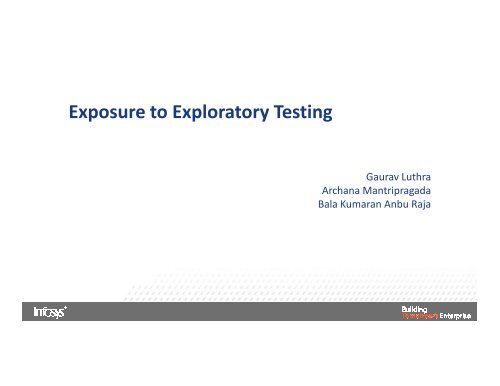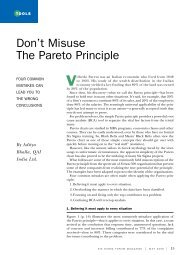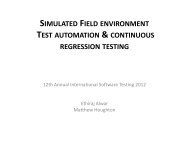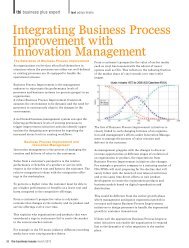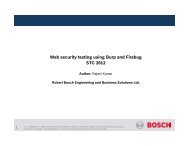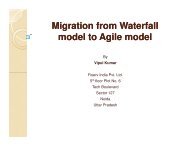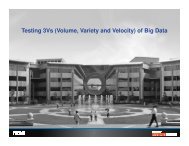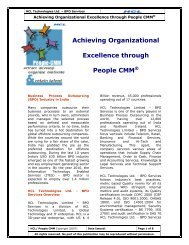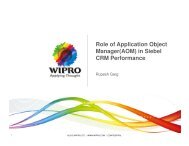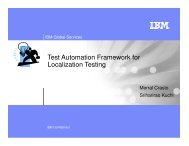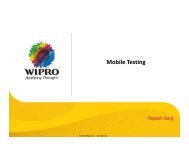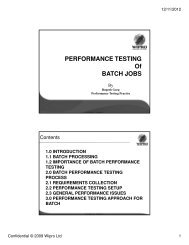Exposure to Exploratory Testing - QAI
Exposure to Exploratory Testing - QAI
Exposure to Exploratory Testing - QAI
You also want an ePaper? Increase the reach of your titles
YUMPU automatically turns print PDFs into web optimized ePapers that Google loves.
<strong>Exposure</strong> <strong>to</strong> Explora<strong>to</strong>ry <strong>Testing</strong><br />
Gaurav Luthra<br />
Archana Mantripragada<br />
Bala Kumaran Anbu Raja
Abstract<br />
• Explora<strong>to</strong>ry <strong>Testing</strong> (ET), useful for discovering new information can be defined as learning simultaneously while planning<br />
and execution.<br />
• Explora<strong>to</strong>ry <strong>Testing</strong> is not a testing technique, but it is the thought that can be applied on any technique. This type of testing<br />
is performed under strict timelines with minimal resource usage. It requires highly skillful and experienced testers with good<br />
working knowledge on the domain and technology.<br />
• Test Case Based (TCB) is a script-based approach focusing on a predefined test case design technique.<br />
• In explora<strong>to</strong>ry testing, a skilled tester will cover all the related aspects of any ad-hoc changes/requirements.<br />
• ET helps a No/Ad-hoc requirement project where an Explora<strong>to</strong>ry Tester can add his thought <strong>to</strong> the requirement if beneficiary<br />
<strong>to</strong> the Project. It also benefits the short term and fixed bid projects.<br />
• Thus in short, with minimum time and effort, tester can maximize the ability <strong>to</strong> find more critical defects in an efficient way.<br />
• In this paper we will discuss and suggest strategies using ET <strong>to</strong> overcome the challenges/hindrances faced in TCB and non-<br />
Requirement based project.<br />
• Test Managers, Test Leads and BAs will benefit from this paper.<br />
BFS-US SSDU Research<br />
2
Test Case Based Approach <strong>Testing</strong><br />
• Script Driven <strong>Testing</strong> follows Analyzing-Planning-Implementing-Reporting approach.<br />
• BRD, LLD and HLD are taken as the source documents and Test plan is prepared.<br />
• Test plan is followed by Test case preparation and Execution covering all the functionalities.<br />
• In TCB, application is not explored and the chances of missing important aspects are high.<br />
• Requirements are covered as per the LLD/HLD given and the testing team follows the same
What is ET ?<br />
Learn<br />
• ET is defined as Interactive process of simultaneous<br />
planning, learning, running and reporting.<br />
• Tester explores the product <strong>to</strong> fulfil the testing mission<br />
Explora<strong>to</strong>ry<br />
Analysis<br />
<strong>Testing</strong><br />
and report the results.<br />
Test<br />
Design<br />
Test<br />
Execution<br />
BFS-US SSDU Research<br />
4
What is ET ? Contd..<br />
Fac<strong>to</strong>rs affecting ET<br />
• Product specifications<br />
• Tester’s knowledge on the product<br />
• <strong>Testing</strong> Strategy<br />
• Available Test data and the documents<br />
• Requirements.<br />
Basics needs <strong>to</strong> be taken care of by the Explora<strong>to</strong>ry tester:<br />
• Careful Observation<br />
• Critical Thinking<br />
• Diverse ideas<br />
• Rich Resources<br />
BFS-US SSDU Research<br />
5
Metrics of ET<br />
Session-based test management (SBTM)<br />
• Session-based test management (SBTM) is for managing ET.<br />
• This technique introduces the idea of a session charters for measures and manages those test ideas. In<br />
these Session Charters, some set of expectations like what kind of work will be completed and how it will<br />
be reported.<br />
• When that session ends, the tester prepares a session report, tagged with important information about<br />
what they did. Each session is characteristically 45 minutes <strong>to</strong> 60 minutes occurs.<br />
Ana<strong>to</strong>my of a Test Session<br />
• These are the status of the ET process. Essentials of Session metrics are Number of sessions<br />
completed, Number of problems found, Function areas covered, and Percentage of session time spent<br />
setting up for testing, Percentage of session time spent testing, and Percentage of session time spent<br />
investigating problems.<br />
SBTM_Sample<br />
Charter_sample1.html<br />
BFS-US SSDU Research
Metrics of ET<br />
Flow Chart<br />
• It is an illustration which portrays a<br />
procedure or the steps of an assignment<br />
(project).<br />
Add<br />
Item<br />
s<br />
Update<br />
Remove<br />
• In ET, we can approximate scenario<br />
activities with a flow chart<br />
• Info seeking is a continuous procedure that<br />
contains lot of steps; real interfaces will<br />
provision changes among these steps with<br />
minimum effort necessary of the user.<br />
• The more unified the connections, the<br />
more attention Testers can devote <strong>to</strong> the<br />
scenario rather than <strong>to</strong> the search <strong>to</strong>ol.<br />
Items<br />
added in<br />
the cart.<br />
At least<br />
one item<br />
must be<br />
in cart.<br />
Updating<br />
on existing<br />
items<br />
The item<br />
must be<br />
in cart.<br />
User deletes<br />
the<br />
particular<br />
item<br />
BFS-US SSDU Research
ET in Different Scenarios<br />
• Illustrates about the application <strong>Testing</strong> of a shopping site say shopfree.com which details us how a defect can<br />
be turned in<strong>to</strong> a requirement.<br />
Scenario Drawbacks of TCB ET<br />
The site has a homepage and<br />
a payment page which<br />
performs the credential<br />
verification and allows the<br />
user <strong>to</strong> shop. Here the page<br />
contains OK and CANCEL<br />
but<strong>to</strong>ns apart from the<br />
credentials which helps us <strong>to</strong><br />
go ahead in<strong>to</strong> the site and<br />
cancel the application<br />
respectively.<br />
• As the LLD/HLD is followed by the test team,<br />
some basic functionalities might get missed<br />
which might turn in<strong>to</strong> a serious defect.<br />
• During the development of test scripts,<br />
found difficulties like some ended obsolete,<br />
deferred, because of changes in software or<br />
hardware or firmware or incorrect<br />
requirement or technical limitations or<br />
schedule limitations.<br />
• During Execution phase, as a round of 4-5<br />
cycles is done on the same Test cases, Tester<br />
might feel it boring performing the same<br />
tests with occurrence of very less bugs<br />
when compared <strong>to</strong> the initial cycles.<br />
• Explora<strong>to</strong>ry tester covers all the<br />
aspects of the Homepage and the<br />
payments page.<br />
• The chances of missing any defects<br />
or instances are less as the<br />
Explora<strong>to</strong>ry tester interacts and<br />
explores the application.<br />
• In this context, Tester while testing<br />
the application checks for the<br />
navigation from payments <strong>to</strong><br />
homepage.<br />
• As there is no specific link provided<br />
in the page <strong>to</strong> navigate <strong>to</strong> the<br />
homepage, this is considered as a<br />
defect which is reported <strong>to</strong> the<br />
development team which can be a<br />
requirement.<br />
BFS-US SSDU Research
ET in Different Scenarios<br />
TCB<br />
Test Report<br />
Test<br />
cases<br />
TC<br />
Preparation(<br />
In mins)<br />
TC<br />
Exection(<br />
In mins)<br />
Total<br />
Duration(In<br />
mins)<br />
Login_1 5 10 20 30 2<br />
Login_2 5 10 20 30 1<br />
Homepage_1 6 12 24 36 3<br />
Homepage_2 7 14 28 42 1<br />
Bugs<br />
ET<br />
Test Report<br />
On-<br />
Chart<br />
er<br />
Off-<br />
Charte<br />
r<br />
Total<br />
Duration(In<br />
mins)<br />
Login_1 32 0 32 2<br />
Login_2 28 0 28 4<br />
Homepage_1 32 1 33 3<br />
Homepage_2 38 2 40 2<br />
Bugs<br />
0.8<br />
0.7<br />
0.6<br />
0.5<br />
0.4<br />
0.3<br />
0.2<br />
0.1<br />
0<br />
Login_1 Login_2 Homepage_1 Homepage_2<br />
Duration(i<br />
n TCB)<br />
(in hours)<br />
Duration(i<br />
n ET)<br />
(in hours)<br />
3.5<br />
2.5 3<br />
1.5 2<br />
0.5 1<br />
0<br />
Bugs(in TCB)<br />
Bugs(in ET)<br />
BFS-US SSDU Research
ET in Different Scenarios<br />
Scenario Drawbacks of TCB ET<br />
Consider an Ad-hoc requirement<br />
based project where the<br />
requirements come dynamically<br />
on the fly on call or through mail.<br />
Requirements here refer <strong>to</strong> rules<br />
which have <strong>to</strong> be followed while<br />
loading data in<strong>to</strong> the table. To<br />
check if the table is loaded in<br />
accordance <strong>to</strong> the rules, queries<br />
are run against table <strong>to</strong> check for<br />
data validation and in case if any<br />
error records found; such records<br />
have <strong>to</strong> be moved <strong>to</strong> Error table.<br />
Resources available for the above<br />
scenario are 1 Test Lead and 2 Test<br />
Engineers.<br />
• Agile projects with dynamically<br />
changing requirements impose great<br />
difficulty for TCB in planning and<br />
strategizing approaches.<br />
• Defect detection rate is low as the<br />
tester is unaware of the inner<br />
functionality of the product.<br />
• Incorporation of requirements in the<br />
correct place is difficult.<br />
• Requirements are documented as a<br />
Flowchart <strong>to</strong> get a clear picture of<br />
all the tests <strong>to</strong> be made.<br />
• ET maintains minimum<br />
documentation and mainly focus<br />
on detecting more defects within<br />
fixed timelines.<br />
• Diverse testing techniques are<br />
followed <strong>to</strong> carry out testing.<br />
• Skilled Explora<strong>to</strong>ry Testers follow<br />
their own approach <strong>to</strong> extract the<br />
output with zero or minimal<br />
planning.<br />
• Explora<strong>to</strong>ry Testers conduct<br />
brains<strong>to</strong>rming sessions with a<br />
group <strong>to</strong> generate various ideas <strong>to</strong><br />
perform testing.<br />
BFS-US SSDU Research
ET in Different Scenarios<br />
Rules<br />
Tester<br />
Bug Report<br />
Fail<br />
Appro<br />
ach<br />
New<br />
Requirements<br />
Pass<br />
Log report<br />
BFS-US SSDU Research
ET in Different Scenarios<br />
Scenario Drawbacks of TCB ET<br />
Localization Web based project for the<br />
financial institution which needs <strong>to</strong><br />
test its application in 6 different<br />
languages. This has multiple releases<br />
which will be tested in two different<br />
environments SIT and UAT. Timelines<br />
are reduced from 4 months <strong>to</strong> 2<br />
months due <strong>to</strong> reduced scope.<br />
Available Resources at the cus<strong>to</strong>mer<br />
site is a team of 6 which includes a<br />
Test lead other all are tester with 2-3<br />
years of testing experience<br />
• Possibility of Pending task at the<br />
end of timeliness is high.<br />
• High possibility that some<br />
requirements are missed while<br />
preparing the test strategy and the<br />
test cases.<br />
• Ambiguity in reporting the defect<br />
as the no of languages tested is<br />
high.<br />
• With tester handling individual<br />
language there is high possibility of<br />
a critical defect getting missed<br />
which may be also be a defect in<br />
the other language.<br />
• Test lead prepares some charter for<br />
the testing.<br />
• The team will split up in teams or<br />
as individuals and start testing the<br />
application covering all the<br />
requirements.<br />
• Approach is taken down on an<br />
excel or a flowchart which might<br />
help as future reference.<br />
• Helps cover all the requirements<br />
with proper defect report.<br />
BFS-US SSDU Research
Advantages of ET<br />
• ET provides complete coverage of the application and accountability.<br />
• ET is structured approach while we’re using session based management testing.<br />
• ET takes very less time compared <strong>to</strong> TCB which in turn saves clients revenue.<br />
• Makes Regression testing easier as the Tester knows the inner functionality of the product which helps in<br />
detecting the defects in less time.<br />
• Skilled testers explore and interact with the product which covers every individual instance of the product.<br />
• Chances of missing defects are quite low.<br />
• Chances of requirements getting missed is very less as the tester here performs a complete test on the<br />
application covering all the basic and critical requirements with his/her knowledge. Even if one tester misses<br />
one it can be discussed with other team members/pair about the scenario.<br />
• Tracking down the task by explora<strong>to</strong>ry tester helps the team <strong>to</strong> run a regression run on it which will help the<br />
team <strong>to</strong> complete the multiple releases and test the same application in multiple environments.<br />
BFS-US SSDU Research
Future Scope<br />
• ET Technique itself is new definition in the testing world. It’s a technique which gives tester a new platform or a<br />
direction <strong>to</strong>wards testing the product. Here the Tester applies his/her skills and performs the testing.<br />
• In near future as the businesses are <strong>to</strong>uching competing targets, this technique can be of great importance.<br />
This is not a separate testing but a technique which can be applied in different type of testing. It can be used<br />
Functional, Au<strong>to</strong>mation, Data warehouse, performance, etc type of testing.<br />
BFS-US SSDU Research
Conclusion<br />
• Explora<strong>to</strong>ry <strong>Testing</strong> is described as simultaneous test planning and execution is a new technique which has<br />
helped the Test managers or Business analyst <strong>to</strong> present a better and challenging approach <strong>to</strong> the testing<br />
practice in software Industry.<br />
• In our paper using the ET technique we are able <strong>to</strong> tackle the various different types of projects having different<br />
type of hurdles with the ease if the testers are skilled and have a will <strong>to</strong> explore.<br />
• With this technique we are in position <strong>to</strong> say that one can decrease the time, work and other resources used in<br />
completing the project when compared with the other strategy. Also the other great achievement is that<br />
quality of testing provided is much better and the defect detecting efficiency is also increased for which testers<br />
are the in the scene of SDLC.<br />
BFS-US SSDU Research
References<br />
• Project Experience<br />
• Explora<strong>to</strong>ry-testing.pdf – By James Bach<br />
• Misconceptions_About_Explora<strong>to</strong>ry_<strong>Testing</strong>.pdf – By Rony Wolfinzon and Ayal Zylberman<br />
• Tu<strong>to</strong>rial on Explora<strong>to</strong>ry <strong>Testing</strong> – By Cem Kaner<br />
• http://www.satisfice.com/<br />
• www.Google.com<br />
• www.Youtube.com (Talk on Explora<strong>to</strong>ry <strong>Testing</strong>-by John Bach)<br />
BFS-US SSDU Research
Q&A
Thank You !


